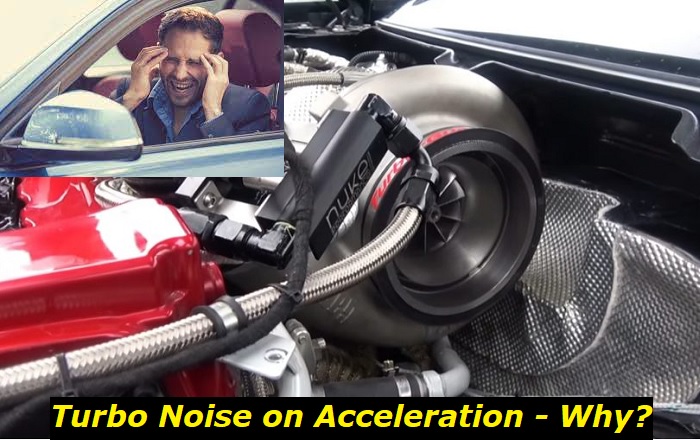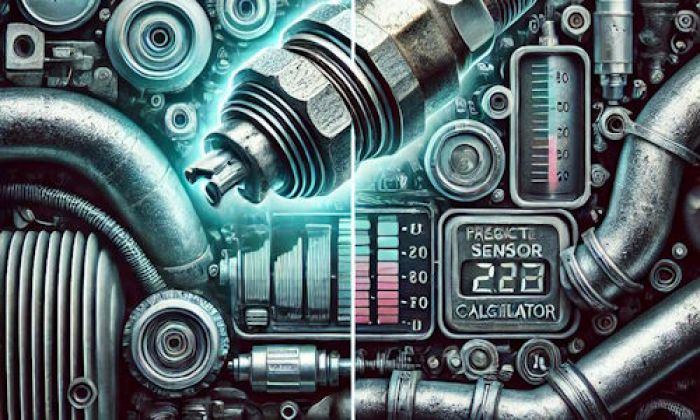Turbochargers (Turbo, for short) are induction devices that use the kinetic energy from the flow of exhaust gases to compress the intake gas in vehicles, thereby forcing more air into the engine and generating more engine power. Everyone, including car manufacturers, loves a good turbo, the performance boost, and sometimes the light whistle that comes with it; but when the whistle gets louder than normal, it becomes a problem.
Turbo problems highlights
- Level of importance:Medium
- Commonreasons:Mileage, age, poor lubrication, internal damage, aggressive use
- DIY inspection:Possible but may be complicated
- DIY repair:Sometimes, possible
- Price for repair:$350 - $800
- Can you drive?In most cases, yes
- Ways to fix:Replace the parts thatare diagnosedto be faulty

How Turbochargers Work
As explained in the introduction, turbochargers are peripheral devices that increase the air in the engine to generate more power even in smaller cars, but how does this happen?
As you probably know, a car engine produces power by combining fuel and air for combustion. When turbos are added to the equation, they use the kinetic energy from the flow of gases in the exhaust to spin a compressor. This compressor then pushes more air into the engine, thereby allowing the engine to burn more fuel in lesser time, consequently producing more power than the engine would produce normally.
It is important to note turbochargers operate at very high temperatures due to the exhaust gases and compressor speed, so it would be very wise to pair up any turbocharger unit with a cooling system.
What Are Turbo Whistles and How Do Turbos Make Them?
While it is arguable that turbochargers reduce the sound produced by engines, because they muffle the sound of air intake to the engines making the engines somewhat quieter, it would be accurate to say that noises would still be produced. The noise generated by turbochargers is called a turbo whistle.
Turbo whistles are light high-pitched sounds heard from the turbocharger's compressor when it is speeding up. So, as you accelerate the car up the rev range, turbo whistles can be heard. Now it should be noted that they do not represent any harm or problem, as long as they still sound like whistles.
When Do Turbo Noises Become a Problem?
As noted earlier, turbo whistles are light. But when these turbo whistles become louder and noisier like a whining sound, screeching sound, drilling sound, or the sound of a police siren, it becomes a symptom of a turbo problem.
A loud, ear-splitting, and noisy turbocharger is most likely a failing turbocharger, needing repair or replacement. Some of the major causes of turbo noise may include;
- Air leaks on the engine air intake route or the cooling system
- Damage to the compressor's wheel
- Split hoses, etc.
Most of them are not problems that would totally damage your turbocharger, so you can always take your car to a turbocharger mechanic for repair.
Other Symptoms of Turbo Failure
Turbo noises are not the only signs that can be interpreted to be symptoms of turbo failure. There are various symptoms of turbo failure and some of them are:
- Extreme Exhaust Smoke
Smoke is one of the most noticeable symptoms of turbo failure. Different smoke emissions mean different problems, but they all signify that there is a problem.
- Black Smoke
When fuel is not burned properly, the unburned fuel most times fuses with other combustion particles, creating a thick mass of black smoke. A common turbo failure that usually results in black smoke is injector leaks and sensor faults. When there are leaks in the injectors, engine air intake route, or sensors, the right ratio of fuel and air (oxygen) is not gotten, so fuel wouldn't be burned properly.
- Blue Smoke
In most cases, blue smoke is seen in the first seconds of starting the car, and the reason is the turbocharger.
Just like engines, turbochargers contain seals that ensure that the oil used by the turbocharger doesn't leak into the turbine housing area of the turbocharger, where it would be burned up. Turbochargers also use piston rings to scrape off excess oil, and in the process, the rings cause wear on the seals. When this happens, the oil leaks into the turbine housing and gets burned up and emitted as blue smoke.
In short, blue smoke also signify leaks, but oil leaks this time around.
- Decreased or Increased Performance/Acceleration
As you know, turbochargers are made to give extra boosts to engines, in order to generate more power. Now, the engine ECU is tasked with determining the boost target value, that is the amount of boost required to generate more power, and if the turbocharger doesn't deliver that target value, it signifies a problem.
If the turbocharger delivers less than the target value, the car won't go as fast as it used to; and if it delivers more than the target value, the car would go faster than it used to.
- Increased Oil Intake
Oil leaks would certainly result in an increased oil intake by the car. So if you notice that your vehicle has started consuming more oil than it usually does, then it's a problem. Normally, if the problem is from the turbocharger, you'll notice it in the turbine housing when you check.
- Check Engine Light
There are so many reasons why you'd be having the check engine light, but most computer diagnostics modern cars can diagnose turbo faults and indicate via the check engine light. But just to be sure, ensure you visit a professional mechanic for proper maintenance and repair
- Inactive boost gauge
In many sports cars and high-end models of other cars, there are boost gauges that show how much the turbocharger is generating. If this boost gauge suddenly stops working or shows a considerable drop or increase, it could be a turbo failure symptom.
This symptom is usually a way of detecting increased or decreased performance.
Causes Of Turbo Failure
- Oil/Lubrication
Just like your engine oil is the lifeblood of your car and its engine, your turbocharger also needs a good and ample supply of quality oil. In the absence of this, your turbo will be filled up with contaminants that could massively cause harm to the turbo.
- Overspeeding
Overspeeding invariably means that you are pushing the vehicle beyond the normal limits, and it could build up gas pressure in the seals. This pressure would result in leaks, which would bring along some problems as well.
Also, speeding makes the turbocharger work harder than usual and wears it out over time.
- Damaged Seals
Just as explained in the smoke symptom, when the seals preventing oil from leaking into the turbine housing are damaged, problems arise from the oil that gets burned. These problems include smoke and an increase in oil usage.
- Foreign Objects/Deposits
Turbochargers have two inlets namely; the compressor inlet and the turbine inlet, and sometimes foreign objects such as dust, sand, dirt, stones, and other small objects can enter the turbocharger through the above inlets.
As it is with most machines and devices, the intrusion of foreign objects will reduce the capabilities of the turbocharger. And these objects, if not taken care of, will even do more harm to parts of the turbocharger.
- Wear And Tear
Turbos are made to be very durable and can last as long as the car, but as it with all things, careless usage like overspeeding and lack of maintenance will result in wear and tear which will further reduce the efficiency of the turbo.
Can you drive with a blown turbocharger?
A blown turbocharger is no joke at all, and therefore shouldn't be taken lightly. So if you think that your turbo is blown, it's a good idea to stop and check the shaft to see if it truly is. And to answer the question, yes. You can drive with a broken/blown turbo, although it is advisable to call for a lift.
Should you choose the latter option of driving with your turbo, here's what you should do to minimize risk.
- Remove the linkage from the wastegate activator, then hold it open with a wire.
- Take it very easy with throttle because your blown turbo's wastegate can't handle the exhaust pressure as it used to.
- Monitor the oil level, and do not exceed 100 miles with a blown turbocharger.
Conclusion
Turbochargers are peripheral devices but their improvement to the performance of cars cannot be underestimated. Therefore, to enjoy their durability, care must be prioritized.
Regular servicing is advised, and management of very bad parts should be avoided. Ensure that you meet professional turbocharger specialists for your servicing and maintenance.
Also, when your turbocharger fails or has failing parts, those parts will drop into the intercooler below while your oil seals fail. Sadly, engines can use this oil until it's dried, at which point they will seize. So, if your turbo fails, ensure you remove all failed parts in order to protect your engine.
About the authors
The CarAraC research team is composed of seasoned auto mechanics and automotive industry professionals, including individuals with advanced degrees and certifications in their field. Our team members boast prestigious credentials, reflecting their extensive knowledge and skills. These qualifications include: IMI: Institute of the Motor Industry, ASE-Certified Master Automobile Technicians; Coventry University, Graduate of MA in Automotive Journalism; Politecnico di Torino, Italy, MS Automotive Engineering; Ss. Cyril and Methodius University in Skopje, Mechanical University in Skopje; TOC Automotive College; DHA Suffa University, Department of Mechanical Engineering






Add comment